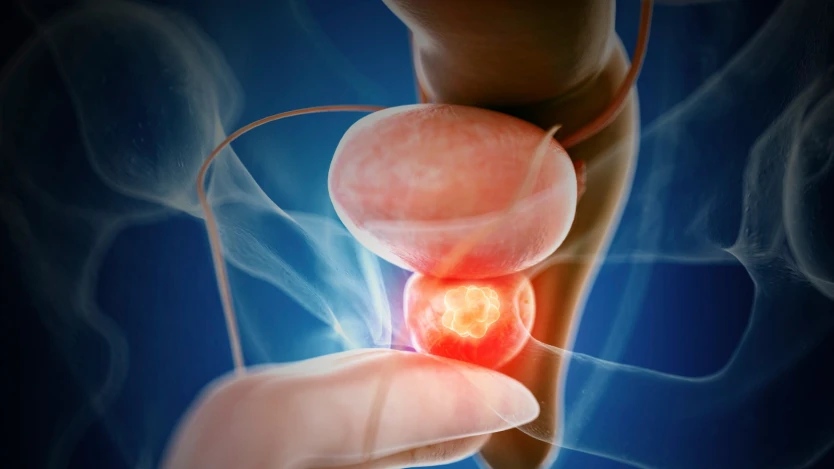Prostate vaporisation: What is it?

- What is BPH?
- Laser prostate surgery
- What does prostate vaporisation involve?
- Benefits of laser prostate surgery
- Bibliography
- Source information
- Frequent Questions
What is BPH?
- Benign prostatic hypertrophy is the most common disease in men over 65 years of age.
- Laser vaporisation of the prostate is a minimally invasive technique that is performed in those patients who are candidates for avoiding open or transurethral surgery.
- Laser vaporisation of the prostate is a surgery that reduces bleeding during and after the procedure.
As you may already know, prostate enlargement occurs over the years, causing obstruction of the urethra and discomfort such as difficulty in emptying the bladder completely or even the need for permanent catheterisation.
BPH is an increase in the size of the prostate gland caused by an increase in hormone levels, such as testosterone.

Do you need laser prostate surgery?
Request a free and immediate appointment with our specialists
In order to reduce the discomfort caused by benign prostatic hyperplasia, there are pharmacological treatments, but these are only palliative in nature, i.e. they help to relax the muscles around the prostate to facilitate urination, but the prostate does not stop growing. So specialists resort to surgical treatments, with laser surgery being one of the most recommended options.
Below you can find all the details about prostate vaporisation, from how it is performed to the benefits it can provide if you are suffering from prostatic hypertrophy.
Laser prostate surgery
Prostate surgery by vaporisation is a minimally invasive procedure that is increasingly being performed to replace conventional open procedures.
Within the type of surgery for benign prostatic hyperplasia, without scarring, we can differentiate between the lasers that are used for vaporisation. However, they all coincide in their usefulness and objective. This is endoscopic prostate surgery and, as such, has the benefit of being less painful, producing less bleeding and having a shorter postoperative stay.
Among the procedures used to reduce prostate size are: the Greenlight Laser, the Thulium Laser and the Holmium Laser.
You can see the main characteristics of each laser used for prostate vaporisation in the following table:
|
Characteristics of lasers available for prostate surgery |
|||
|
Greenlight Laser |
Thulium Laser |
Holmium Laser |
|
|
Surgery time |
30 - 45 min. |
30 - 45 min. |
30 - 45 min. |
|
Size of the prostate |
< 60 cc |
Any size* |
Any size* |
|
Full Recovery |
2 weeks |
3 - 4 days |
3 - 4 days |
|
Technique |
Vaporisation |
Vaporisation / Vapo-resection |
Vaporisation / Enucleation |
|
Allows tissue analysis |
No |
Yes |
Yes |
*Always taking into account the assessment of the specialist to confirm the feasibility of the treatment.
Prostate vaporisation to treat benign hyperplasia allows the specialist to treat small and medium-sized prostates with great versatility, as well as to successfully treat large prostates.
In addition, laser prostate surgeries stand out for their easy access to the area to be treated, the versatility of the surgical material and, above all, for being very safe procedures. Likewise, for patients, this surgery guarantees the reduction of haemorrhage both during and after the operation, allowing a short hospital stay and a quick recovery.
What does prostate vaporisation involve?
Laser vaporisation involves inserting a laser fibre through the urinary tract into the prostatic urethra to vaporise the benign tissue and remove it. The increased energy of the device allows rapid vaporisation with a high coagulation capacity.
To perform the procedure, the specialist will carry out the following steps:
- First, the specialist will administer a general anaesthetic so that you do not feel any discomfort during the procedure.
- Once it has taken effect, the cystoscope and the laser fibre are inserted through the urethra, which has previously been dilated.
- Depending on the laser chosen, the vaporisation technique will consist of the following:
- Holmium Laser by Vaporisation (HoLAP). The cuts made to remove the tissue are very precise, allowing for a reduction in intraoperative bleeding. However, this technique is only indicated for prostates weighing no more than 50 grams.
- Thulium laser, by vaporisation. The prostate tissue is evaporated by heating it. The intracellular water reaches up to 100 degrees, thus minimising common bleeding and creating a haemostatic effect.
- Greenlight Laser. The tissue is vaporised and the surrounding tissues are cauterised. This technique is indicated for prostates of no more than 60 cc.
- Once all the prostate tissue has been removed, all the instruments are removed and a probe is left in place to remove any debris left inside.
Prostate vaporisation is performed under general or regional anaesthesia and lasts only 30-45 minutes.
Unlike traditional prostate surgery, laser vaporisation surgery does not cut or scrape the tissue. This results in less blood loss, which is why vaporising laser surgery is often a recommended option for people who have blood clotting problems or who take blood thinners.

Benefits of laser prostate surgery
As you have read, laser vaporisation of the prostate has numerous benefits in addition to eliminating the problems caused by benign prostatic hyperplasia and restoring your quality of life. Here are some of the other benefits of this minimally invasive technique:
- Faster surgery: mainly the Tulio laser. This allows surgery to be performed in just 30-45 minutes.
- Less intraoperative bleeding: thanks to the use of the laser, it is possible to produce a haemostatic effect (cauterisation) of the tissue around the vaporised area, thus minimising bleeding as much as possible and considerably reducing hospitalisation and recovery time.
- Reduced hospital stay: the time you spend in hospital is reduced from 3 to 6 days after TURP surgery to just 24 hours, in most cases, after prostate laser surgery.
- Minimal complications: the characteristic properties of each of the lasers and the precision achieved with these techniques ensure that the process is minimally invasive and with minimal complications.
- Allows treatment of patients at risk: thanks to the singularities of the laser method, patients with heart conditions, advanced age or anticoagulant receptors are possible candidates to undergo prostate surgery with laser, something that is almost totally inadvisable for conventional surgeries.
If you have a clear diagnosis of BPH and you are thinking of treating your prostate problems with laser surgery, we remind you that you can request a free surgical assessment appointment with the Urology specialist by calling on +34 91 141 33 56, filling in the contact form for us to call you back or, if you prefer, by clicking below:

Do you need laser prostate surgery?
Request a free and immediate appointment with our specialists
Bibliography
- MINISTERIO DE CIENCIA E INNOVACIÓN. (2009, abril). Tratamiento de la hiperplasia benigna de próstata mediante láser. Propuesta de indicadores para su evaluación. Recuperado de https://www.sergas.es/docs/Avalia-t/avaliat200904-hiperplasia-prostata.pdf
- Sountoulides, P., Kaufmann, O., Kikidakis, D., & Pardalidis, N. (2010). VAPORIZACIÓN FOTOSELECTIVA DE LA PRÓSTATA (VFP) vs ENUCLEACION DE LA PRÓSTATA CON LÁSER HOLMIO (HOLEP): RESULTADOS ACTUALES Y ESTRATEGIAS. Recuperado de http://scielo.isciii.es/pdf/urol/v63n2/01.pdf
- Vicente Rodríguez, J., Fernández González, I., Hernández Fernández, C., Santos Gracia-Vaquero, I., & Rosales Bordes, A. (2006). Láser en Urología. Recuperado de http://scielo.isciii.es/pdf/aue/v30n9/v30n9a05.pdf
Dr. Antonio Rebollo Marina
Médico Asistencial en Centro Médico Caser
Nº colegiado: 282834715

Medical disclaimer: All the published content in Operarme is intended to disseminate reliable medical information to the general public, and is reviewed by healthcare professionals. In any case should this information be used to perform a diagnosis, indicate a treatment, or replace the medical assessment of a professional in a face to face consultation. Find more information in the links below:
Frequent Questions
-
What is prostate vaporisation?
Laser prostate surgery consists of the introduction, through the urethra, of the laser optic fibre through a cystoscope that works with a beam of light (the wavelength will depend on the type of laser energy used).
Thanks to the high power of the laser, the prostate is vaporised, turning it into water vapour. At the same time, the blood vessels are photo-sealed and by using saline, the possibility of fluid reabsorption is minimised and the possibility of bleeding is greatly reduced. Read more
-
How is the prostate reduced?
Several surgical techniques are available to reduce the size of a prostate affected by benign prostatic hyperplasia. These are:
- Conventional ones such as transurethral resection (TURP) or open prostatectomy.
- The ureteral release operation with the Urolift system (effective only in prostates of a certain size).
- Prostate surgery with laser: Greenlight, Holmium or Thulium. Read more
-
How long does prostate surgery take?
The approximate duration of a prostate laser surgery is between 30 and 45 minutes.
This time may vary depending on the characteristics of each case as well as the particularities of each patient. Read more
-
What is the greenlight laser for the prostate?
The greenlight laser is a minimally invasive technique for treating benign prostatic hyperplasia (BPH). This type of laser is characterised by:
- Less bleeding during the procedure.
- Rapid recovery.
- Shorter hospital stay.
-
What is the Thulium laser?
The Thulium laser is a technological alternative that allows minimally invasive transurethral resection for prostate reduction surgery. It is characterised by its speed of action, significantly reducing surgical time.
Likewise, its ability to act exclusively on the prostate without affecting the surrounding tissues guarantees a quick and painless recovery.
-
What is the Holmium laser?
The Holmium laser is a minimally invasive treatment, compared to open surgery or transurethral resection.
The Holmium laser is the indicated treatment for prostates larger than 60 cc and even larger than 100 cc.
